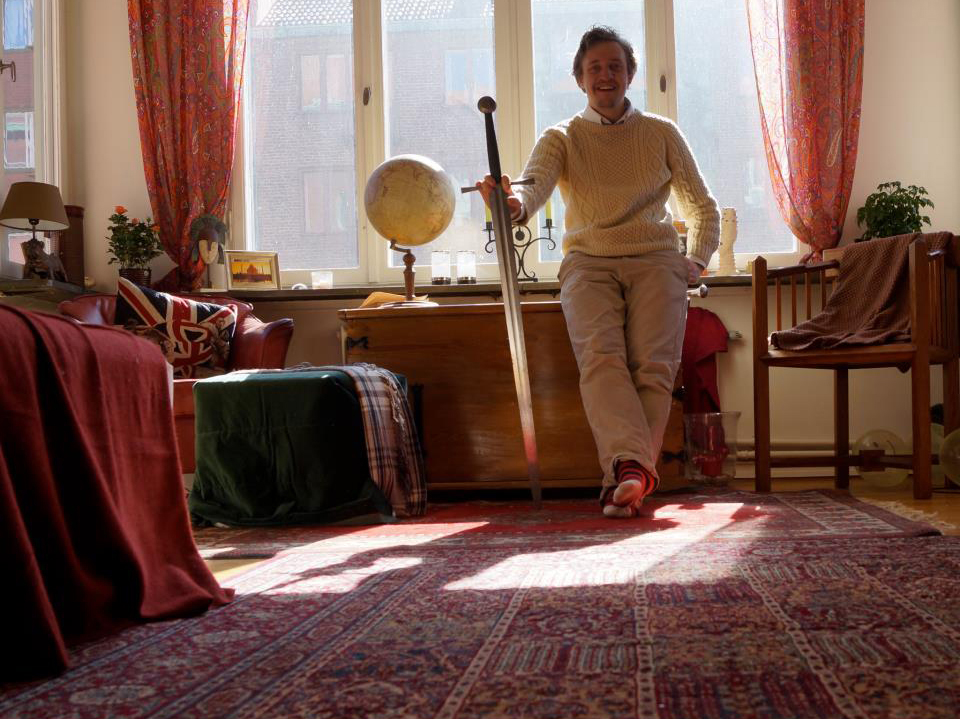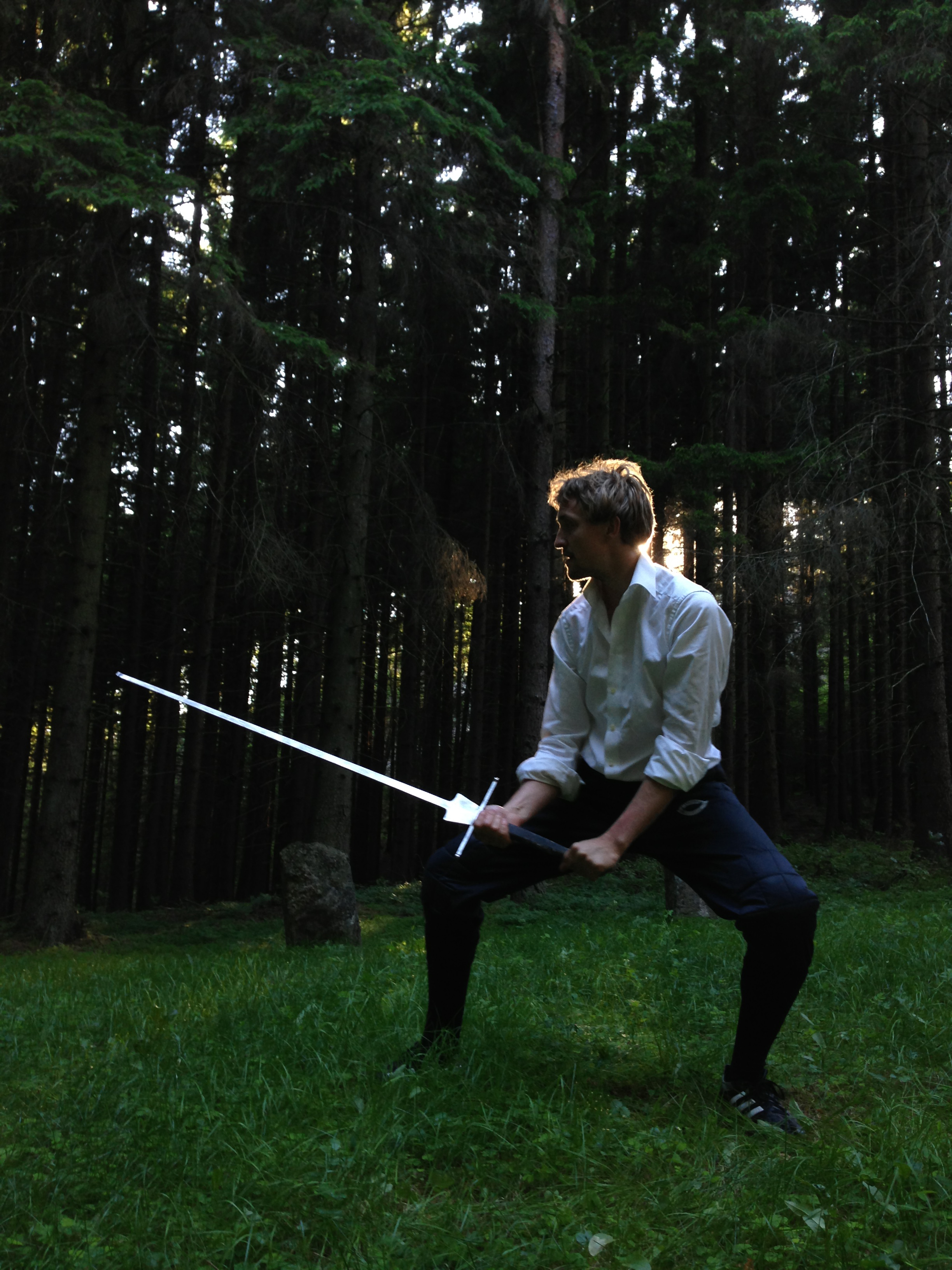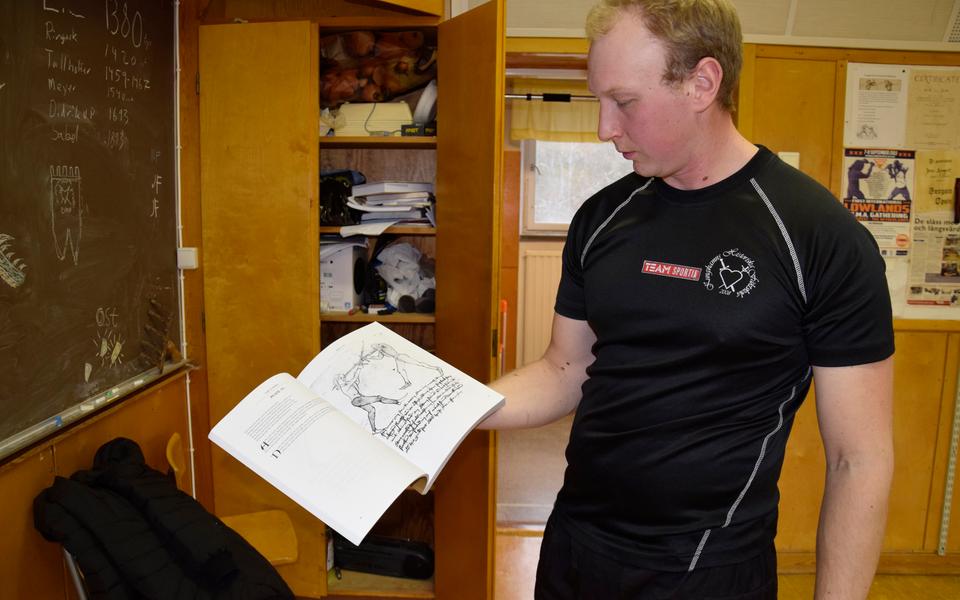Most people know him as one of the commentators on the Swordfish livestream. We sat down with Scott Hellroth to talk about how presentation of historical fencing is important and where he thinks HEMA is going in the future.

We’ve come a long way in historical fencing in terms of how we present ourselves. It’s easy to take these gains for granted, or to think that we are now at the end of the line and that what we see now is set in stone. But the changes in HEMA are often the result of visions of individuals and there is still an urge for further developments. One person who has had a greater influence than is commonly known, is Scott Hellroth of Gothenburg Historical Fencing School.
Swordfish 2011 was the first major HEMA event to livestream competitions. The dynamic duo Scott Hellroth and Matt Galas were asked to do the commentary, and Scott also presented the fights on the matt. An avid MMA fan, he declared the fights like a Las Vegas announcer. But before the event, he had discussed with leaders what HEMA is and what it should be and he knew that historical fencing was looking to find its footing. What should be the style? Should inspiration come from tennis or MMA? Should it be more historical? Should it be something entirely different? He wanted to try things out and get a response.
We knew that over time we should go towards a classical direction. We were clear on that, but right then, we needed to toughen up
The very idea of Swordfish’s competitions was to push the limit—to force fencers to toughen up and put competitions at the centre of attention to see what would happen when they were under pressure. Who would push through and shine, and who would crumble? Swordfish wanted to change the view on fencing and what it means to be a fencer. It begged the question: can you pull off the techniques you talk about on social media against an uncooperative opponent in a stressful environment?
The background to this was that in the early days of HEMA the internet was the thing that connected us all, but with that also came a theoretical focus that sometimes seemed to miss the point of what a martial art is. There were, frankly, a lot of prominent people who could not fence well and who no one would describe as modern versions of the warlike fencing masters whose arts they were recreating. In fact, very few of us could live up to that image and we needed an arena to test ourselves in. At the same time as HEMA was gaining traction, MMA had become a household name. So, should HEMA be inspired by the rougher modern sport of MMA?
“I wanted to test the waters and provoke a bit, force people to react and to take a stand on the direction we should go,” Scott explains. “At the time we were in the middle of a movement in the HEMA community and Gothenburg Historical Fencing School had made a shift where we created a more fight-oriented event, but even so, we knew that over time we should go towards a classical direction. We were clear on that, but right then, we needed to toughen up.”
Just as predicted, the style of announcement received some backlash and people wanted a less Las Vegas-like approach.
The outward expression and inner truth
The history of the style of the announcements shows how important the details of presentation are. The outward expression should tell you something of the inner world of what is being shown, and that is where the MMA-styled presentations missed the mark. For Scott this is something that goes beyond the ring.
“This probably annoys me more than it should; you see young men dressed to their teeth in three-piece suits and a couple of hours later they are shit-faced and the shirt is hanging out of their flies. The style you present should be a reflection of your personality and resolve, it carries meaning,” he says.

The underlying ideal is not the same in fencing as in MMA, so what is it? The sword carries a lot of meaning and has perhaps also an air of a classical world, or for some even a fantasy world, but this also creates a disconnect. When trying to embody the image and ideal of the sword it becomes a charade—they want to be something they are not. It remains an ideal image, but not a reflection of who they are. Even though an ideal image can be an aspiration, it’s also easy to see how image and style can be superficial—something paper thin and lacking in weight.
Nothing is missing, they just haven’t found their way yet.
“Look, you have all these guys coming to HEMA who are wearing a proverbial Lothlorien leaf because it represents something that they want to be, an ideal. And it’s not a bad thing, having an ideal to strive for is a good thing, but it can only take you part of the way. At some point you will have to face up to your own shortcomings. You are mimicking fairytale figures because they reflect what you want to be on some level. But you can’t just dress the part, you have to confront your own weaknesses, your cowardice and fears and flaws to come closer to your ideal,” Scott explains.
I ask him what is missing in these people.
“Nothing is missing, they just haven’t found their way yet. You can’t sit online and find it either. There are still a lot of people in HEMA who are funny or smart and they make names for themselves online, but that’s clearly not enough to become what you want to become in terms of a historical fencer. Underlining this, most of us don’t come to HEMA primarily to learn how to fight, because then we could’ve joined a boxing club. We are searchers.”
There’s something that is quite disturbing for a lot of people in this, because it means that although they are dressing up for a part, they are not capable of filling the shoes. Fencing risks being LARPing and the fencer to look like a fool who is unable to grow up. It’s not just because there are no elves or orcs in real life, but also because if these people were truly facing the orcish horde they would run and hide. Whereas someone who is made out of sterner stuff, like a member of Hells Angels, would be far more likely to get into the fight, regardless of the cost for himself. So why do they chose to mimic fairytales, and not Hells Angels?
“Because the elves are a representation, the Hells Angels are something real. And there’s a great risk with having ideals without living up to them, because you end up like bullshido. This is where training and facing your fears come in. Martial arts test you. You may have this image of yourself, but when you get completely thrashed in a competition, you have to go back to the training hall and build yourself up again. You can’t blame the judges. You should accept your defeat and use it to confront yourself. And that’s where the transformation happens, when a guy who used to be nerdy and maybe awkward turns himself into something else,” Scott says.
The presentation then becomes an embodiment of what fencing should be. The culture which we believe should permeate fencing is something to strive for, something to get inspired by, but it has to go deeper than just looks or online bravado. It has to be backed up by actual qualities in a person.
The best fencers embody their ideals
So, what is it about HEMA’s prominent fencers? A lot of them seem to almost manifest some of the ideals of fencing. Fencers like Kristine Konsmo, Jan Chodkiewicz, Axel Pettersson, John Clements, Dennis Ljungqvist, Lee Smith, Jake Norwood or Carl Ryrberg are very different from each other on some levels, but they share a commonality in that they are archetypical in a way. They have carved themselves out of what they were, into something they wanted to be. So, what can we learn from them?
“To confront ourselves. The ability for a fencer to see yourself and break yourself down completely in your analysis of who you are. A fencer has to have a sense of himself and be able to address and clearly see his own shortcomings. I went to a seminar with Axel once and it was sort of lame, and I told Axel that I thought so. He responded that if you listened for an hour and a half and there was just one thing you got out of it, it was worth it. I was so full of myself at the time, I thought I was so much better than everyone else there. But he, who knows more than anyone I know, was still ready to be a student. That’s humility. You have to be prepared to look for the truth.”
I ask him what his advice to new fencers is.
“Be humble and do what you fear most.”
MMA, the beast and chivalric virtues
We keep returning to humility, discipline, honesty and other things that sound an awful lot like classical virtues. But there’s an elephant in the room. Back in the day when the fencing arts were written down, the warrior elites could use violence at their own pleasure. Period writers on chivalry, like Geoffroi de Charny, reveal that chivalry is put in place not only to promote martial endeavours, but also to tame the violent beast in some regard—to put mankind’s Fenris wolf in chains. They asked of the knight to be humble, to safeguard the poor, to show mercy and to act morally, because the knight very much had the capability to do much evil if left with no restrictions. The raw violence had to be controlled. That’s the opposite situation to what we have today. We are so excessively socialized that we feel a great need to reawaken some of that inner beast. In MMA for example, that beast is the selling point, regardless of how true or not that image is. Geoffrei de Charny justifies the existence of the knights by saying that they suffer and live hard lives. It attaches the knight to the Christian notion of suffering being something good, because Jesus suffered. Much of this is alien to a lot of modern people. The Lothlorien leaved person who comes to HEMA is not really in need of more self-control, is he? He hasn’t awoken his inner beast, but just wants to wear the suit, flash the symbols.
“But the beast is within us all,” Scott says. “By confronting your own short-comings you will see that too, and that is useful because you never know when history repeats itself. Knowing about your darkness makes you a better person. And restraints are useful to you regardless, it’s about discipline and taking control by challenging yourself. That is true for both MMA and fencing.”
Facing your fears
Scott himself is no stranger to facing up to reality. In 2004 he walked into GHFS and was full of mischief and talent. He was unruly, and disrespectful in a fun way, always ready to create a little mayhem just for the hell of it. He was still an unknown entity when he started drunk dialing famous HEMA people in the middle of the night, coming up with funny stories or just to pester them. In the pursuit of getting hold of his big hero John Clement’s number, he made it through Scott Brown, Christian Tobler, Greg Mele, Jake Norwood and some other people before finally reaching John Clements himself.
But behind the happy go lucky attitude some problems were lurking. Getting drunk dialed by the mysterious Swede had become a mark of honour. If you had been the victim, you knew you were a name in HEMA, but over the years, the man who was famed for his funny rants and irreverence, hit a wall and realized he had to stop drinking. Alcohol had become part of a destructive pattern, and from that day he hasn’t touched a drop.
Taking HEMA into the future
Now HEMA is at a cross roads again, Scott says. That time back in 2011 when we were exploring the competitive approach was important and it still is. The Swedish sense of organization was great, and pushed progression in terms of professionality and martial skills. But Scott says we’re still not quite there in terms of creating a good representation for historical fencing.
“A good comparison is karate and sumo wrestling. A lot of the time you can’t tell if a karate competition is performed or if it is some other martial art. It can be held in a basketball arena, or wherever. It has lost a lot of things that are typical and representative of Japanese culture and its own traditions, thereby it tells its story poorly. By comparison, sumo wrestling is a perfect balance. You have a raised ring, traditionally dressed referees, and ceremonies that have meaning within sumo wrestling and Japanese tradition. You could remove the wrestlers and you would still see what it is. We spoke about this ten years ago, but I think that we should try to make fencing more in line with what it is. It’s a balance though, if you go too far it just looks ridiculous, it has to be just enough, but not more.”
Will Sweden be prominent in this development?
“No. Well, we could be, I guess, but we were great at creating structure and we are great at bureaucracy. But the Italians… they are great at building culture. I think they will lead the way, and they have a sense of style which can get the balance right. I want to see competitions in some piazza, with a referee with the right amount of historical garb and ceremonies—every detail just right.”
As for himself, he’s not certain what the next step will be.
“Maybe going to Georgia and meet those guys doing their sword and buckler tradition. There’s something there, going up into the mountains and exploring that. That resonates with me. Maybe that’s my next curtain to peer behind.”






